What’s the next best thing to going to the movies, taking in a play, or watching TV? Reading good books about movies, theatre, and TV, of course. And there’s still a couple of days left to stuff a few stockings with these.
 The Art of Hammer: The Official Poster Collection from the Archive of Hammer Films Does Marcus Hearn have the sweetest job or what? I assume someone’s paying him to pen intros and other supplementary material for jaw-dropping collections like this one, a delectable assortment of poster art from Hammer Films, which recently returned from the dead with the superior Let Me In. I grew up on Hammer horror, and this assemblage of blood-dripping posters really took me back, not only to a golden age in movie mayhem, but to a wondrous time in movie marketing. Sure, some of it was pure ballyhoo–I don’t recall as many night creatures in the actual film of that name, or as many extras in She (1965) as in the artwork. What it wasn’t, though, was pedestrian, like so much movie advertising today. These throb with energy, crawl with monsters, and pulse with sex, too; by the early 70s the posters, like the films, had gone topless, at least in certain territories. This is a pleasingly wide-ranging survey, and a must for the Hammer fan in your life.
The Art of Hammer: The Official Poster Collection from the Archive of Hammer Films Does Marcus Hearn have the sweetest job or what? I assume someone’s paying him to pen intros and other supplementary material for jaw-dropping collections like this one, a delectable assortment of poster art from Hammer Films, which recently returned from the dead with the superior Let Me In. I grew up on Hammer horror, and this assemblage of blood-dripping posters really took me back, not only to a golden age in movie mayhem, but to a wondrous time in movie marketing. Sure, some of it was pure ballyhoo–I don’t recall as many night creatures in the actual film of that name, or as many extras in She (1965) as in the artwork. What it wasn’t, though, was pedestrian, like so much movie advertising today. These throb with energy, crawl with monsters, and pulse with sex, too; by the early 70s the posters, like the films, had gone topless, at least in certain territories. This is a pleasingly wide-ranging survey, and a must for the Hammer fan in your life.
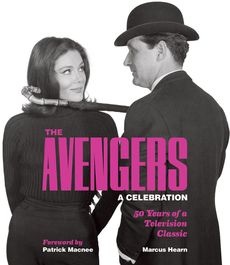 The Avengers: A Celebration: 50 Years of a Television Classic Hearn once again guides us through another pop culture phenomenon, concentrating on its 60s heyday and omitting the spinoffs and the unspeakable bigscreen version of 1998. Fittingly the foreword goes to John Steed himself, Patrick Macnee, full of praise for his delectable co-stars (we in the colonies remember Diana Rigg, but future Goldfinger Bond girl Honor Blackman and Linda Thorson bookended her iconic tenure)–and, incidentally, recalling just what it was that was being avenged, at least in the program’s earliest incarnation. After that it’s a romp through stills: behind-the-scenes shots, villains, guest stars, and fashions (Rigg grew to dislike her famous leather outfits). A book can’t capture the show’s indelible wit but leafing through it you can’t help but hum Laurie Johnson’s unforgettable theme.
The Avengers: A Celebration: 50 Years of a Television Classic Hearn once again guides us through another pop culture phenomenon, concentrating on its 60s heyday and omitting the spinoffs and the unspeakable bigscreen version of 1998. Fittingly the foreword goes to John Steed himself, Patrick Macnee, full of praise for his delectable co-stars (we in the colonies remember Diana Rigg, but future Goldfinger Bond girl Honor Blackman and Linda Thorson bookended her iconic tenure)–and, incidentally, recalling just what it was that was being avenged, at least in the program’s earliest incarnation. After that it’s a romp through stills: behind-the-scenes shots, villains, guest stars, and fashions (Rigg grew to dislike her famous leather outfits). A book can’t capture the show’s indelible wit but leafing through it you can’t help but hum Laurie Johnson’s unforgettable theme.
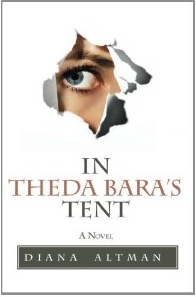 In Theda Bara’s Tent Diana Altman, author of the non-fiction Hollywood East: Louis B. Mayer and the Origins of the Studio System, saw my coverage of Turner Classic Movies’ Moguls & Movie Stars series on the Cineaste website and sent me a copy of her new historical novel, in which Mayer, here a struggling 22-year-old theater owner, and a plucky nine-year-old orphan, Harry Sirkus, begin an odyssey that will take them to dizzying heights in Hollywood. What happens in Theda Bara’s tent? I’m not tellng, except that it may help to know who Theda Bara is before reading. Or maybe not–Altman, the daughter of the MGM talent scout who discovered a galaxy of stars including Joan Crawford and James Stewart, knows this milieu inside and out, and brings it to vivid life for TCM addicts and newcomers alike in engaging and entertaining fashion. Sample observation: “It was a myth that the cigarette-smoking, short-skirt-wearing, free-love-talking girls of the Jazz Age were promiscuous. They were as prudish as their mothers.”
In Theda Bara’s Tent Diana Altman, author of the non-fiction Hollywood East: Louis B. Mayer and the Origins of the Studio System, saw my coverage of Turner Classic Movies’ Moguls & Movie Stars series on the Cineaste website and sent me a copy of her new historical novel, in which Mayer, here a struggling 22-year-old theater owner, and a plucky nine-year-old orphan, Harry Sirkus, begin an odyssey that will take them to dizzying heights in Hollywood. What happens in Theda Bara’s tent? I’m not tellng, except that it may help to know who Theda Bara is before reading. Or maybe not–Altman, the daughter of the MGM talent scout who discovered a galaxy of stars including Joan Crawford and James Stewart, knows this milieu inside and out, and brings it to vivid life for TCM addicts and newcomers alike in engaging and entertaining fashion. Sample observation: “It was a myth that the cigarette-smoking, short-skirt-wearing, free-love-talking girls of the Jazz Age were promiscuous. They were as prudish as their mothers.”
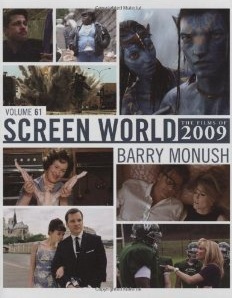 Screen World and Theatre World Time waits for no reviewer; I had the previous editions of these on my desk when the latest showed up. What’s changed are the years under consideration: Screen World Vol. 61, by Barry Monush, offers you a ticket to last year’s cinema attractions, while Theatre World Vol. 66, co-edited by Ben Hodges and Scott Denny, gives you an aisle seat for 2009-2010 on the American stage. What hasn’t changed is the impeccable quality that has distinguished these must-have volumes for decades–web schmeb, it’s easier and more fun to find what you’re looking for in these books, amidst a handsome selection of black-and-white photographs. Contents include introductory essays, lists of highlights and awards, full credits information for hundreds of films and productions, and obituaries. Oh, and my name’s on page 371 of Theatre World Vol. 65, as a Drama Desk board member. Mom’s copy is on its way.
Screen World and Theatre World Time waits for no reviewer; I had the previous editions of these on my desk when the latest showed up. What’s changed are the years under consideration: Screen World Vol. 61, by Barry Monush, offers you a ticket to last year’s cinema attractions, while Theatre World Vol. 66, co-edited by Ben Hodges and Scott Denny, gives you an aisle seat for 2009-2010 on the American stage. What hasn’t changed is the impeccable quality that has distinguished these must-have volumes for decades–web schmeb, it’s easier and more fun to find what you’re looking for in these books, amidst a handsome selection of black-and-white photographs. Contents include introductory essays, lists of highlights and awards, full credits information for hundreds of films and productions, and obituaries. Oh, and my name’s on page 371 of Theatre World Vol. 65, as a Drama Desk board member. Mom’s copy is on its way.
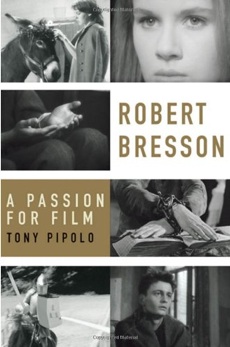 Robert Bresson: A Passion for Film If you saw 127 Hours and thought “WWBD?” (“What would Bresson do?”) this is the book for you. (The answer can be found in one of his greatest films, A Man Escaped–he would have stayed with its protagonist through every step of his confinement, no fancy ways-outs for him or for us via editing.) I’m only being a little facetious with my reference; for some critics the French filmmaker is a kind of Christ figure, whose work burns with aesthetic purity. Tony Pipolo, a Cineaste contributor, brings us a filmmaker fascinated with “faith and doubt,” and offers extensive critical commentary on all of his movies, none of which are likely to be remade (though Pickpocket greatly influenced the career of Paul Schrader, particularly his Taxi Driver screenplay, and Au hasard Balthazar has been mentioned in conjunction with Steven Spielberg’s upcoming War Horse). This is a book as uncompromising as its subject, “a highly personal response to these films and to the artistry of their maker,” Pipolo writes, and an excellent guide to your own exploration. (Pickpocket and Balthazar are both Criterion Collection titles.)
Robert Bresson: A Passion for Film If you saw 127 Hours and thought “WWBD?” (“What would Bresson do?”) this is the book for you. (The answer can be found in one of his greatest films, A Man Escaped–he would have stayed with its protagonist through every step of his confinement, no fancy ways-outs for him or for us via editing.) I’m only being a little facetious with my reference; for some critics the French filmmaker is a kind of Christ figure, whose work burns with aesthetic purity. Tony Pipolo, a Cineaste contributor, brings us a filmmaker fascinated with “faith and doubt,” and offers extensive critical commentary on all of his movies, none of which are likely to be remade (though Pickpocket greatly influenced the career of Paul Schrader, particularly his Taxi Driver screenplay, and Au hasard Balthazar has been mentioned in conjunction with Steven Spielberg’s upcoming War Horse). This is a book as uncompromising as its subject, “a highly personal response to these films and to the artistry of their maker,” Pipolo writes, and an excellent guide to your own exploration. (Pickpocket and Balthazar are both Criterion Collection titles.)
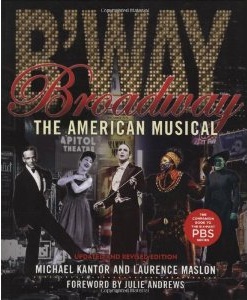 Broadway: The American Musical PBS’ excellent, Emmy-winning 2004 history of the same name could use an update (and a rebroadcast), hint hint. While we wait the show’s creator, Michael Kantor, and co-writer Laurence Maslon have revised their equally accomplished companion volume. Besides bringing us up to date through the 2009-2010 season this trade paperback edition has a new foreword by Julie Andrews, who, synergy in action, narrated the program. “They’re wondrous things to pull off,” she remarks. “A great musical is something to be cherished forever. The cast album becomes a friend.” So will this gorgeously appointed book, rich with photos and quotes and backstage info-nuggets–the stories behind Oklahoma! and West Side Story, to name two classics, are page-turners– and welcoming The Light in the Piazza, Spring Awakening, and In The Heights to the fold.
Broadway: The American Musical PBS’ excellent, Emmy-winning 2004 history of the same name could use an update (and a rebroadcast), hint hint. While we wait the show’s creator, Michael Kantor, and co-writer Laurence Maslon have revised their equally accomplished companion volume. Besides bringing us up to date through the 2009-2010 season this trade paperback edition has a new foreword by Julie Andrews, who, synergy in action, narrated the program. “They’re wondrous things to pull off,” she remarks. “A great musical is something to be cherished forever. The cast album becomes a friend.” So will this gorgeously appointed book, rich with photos and quotes and backstage info-nuggets–the stories behind Oklahoma! and West Side Story, to name two classics, are page-turners– and welcoming The Light in the Piazza, Spring Awakening, and In The Heights to the fold.
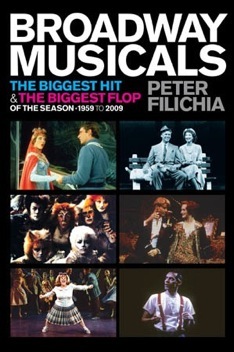 Broadway Musicals: The Biggest Hit & The Biggest Flop of the Season, 1959 to 2009 There are lots of “wondrous things” in Peter Filichia’s cheeky, exuberant survey, like The Sound of Music and Oliver! and Jersey Boys–but if you’re like me you’ll dive deep into the lower depths, where you’ll find shows so unsuccessful some of them died in out-of-town tryouts, or racked up dubious distinctions. (The ill-starred Breakfast at Tiffany’s musical, from the 1966-1967 season, was the first to close in previews, helped to its doom by a book penned by that noted light comedy writer Edward Albee.) If Stephen Sondheim is tired of his endless 80th birthday celebration and all those reminders of his genius, he’ll appreciate Filichia’s popping of his celebratory balloons–three of his shows, Anyone Can Whistle, Merrily We Roll Along, and Wise Guys, are among the tone deaf. (For all his great and innovative work he’s never had an outstanding hit.) The $65 million-and-counting question hanging over the current season, one that Filichia will no doubt answer in a future edition: which side of the ledger will Spider-Man: Turn Off the Dark wind up in?
Broadway Musicals: The Biggest Hit & The Biggest Flop of the Season, 1959 to 2009 There are lots of “wondrous things” in Peter Filichia’s cheeky, exuberant survey, like The Sound of Music and Oliver! and Jersey Boys–but if you’re like me you’ll dive deep into the lower depths, where you’ll find shows so unsuccessful some of them died in out-of-town tryouts, or racked up dubious distinctions. (The ill-starred Breakfast at Tiffany’s musical, from the 1966-1967 season, was the first to close in previews, helped to its doom by a book penned by that noted light comedy writer Edward Albee.) If Stephen Sondheim is tired of his endless 80th birthday celebration and all those reminders of his genius, he’ll appreciate Filichia’s popping of his celebratory balloons–three of his shows, Anyone Can Whistle, Merrily We Roll Along, and Wise Guys, are among the tone deaf. (For all his great and innovative work he’s never had an outstanding hit.) The $65 million-and-counting question hanging over the current season, one that Filichia will no doubt answer in a future edition: which side of the ledger will Spider-Man: Turn Off the Dark wind up in?




Comments